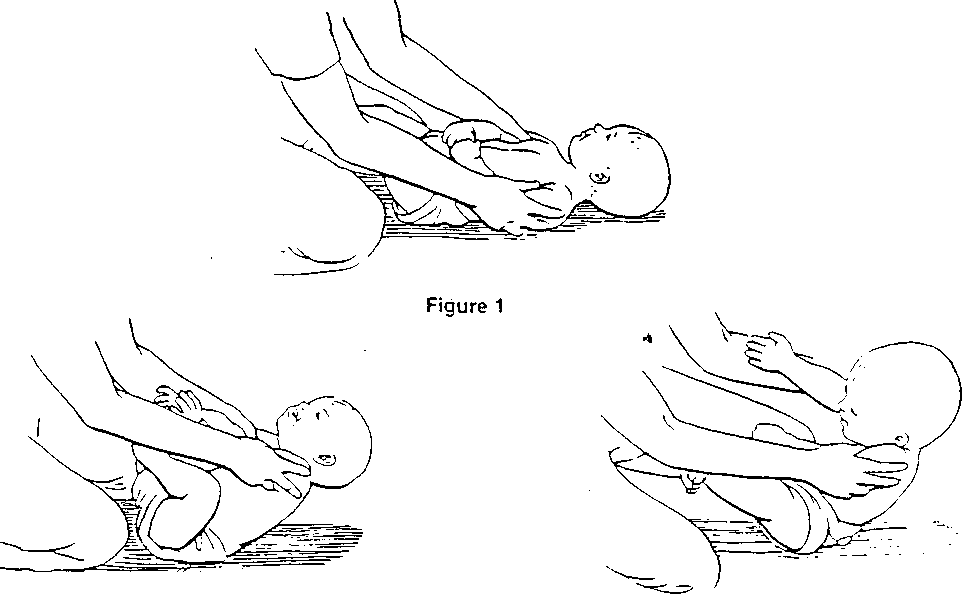90 HOME INSTRUCTIONS
Trunk Relaxation in Sitting
Purpose
To aid in relaxation of muscle tone in trunk
Instructions
1. Place child sitting sideways on your lap, with arms forward. Support child behind the head, not behind the neck.
2. Gently press on front of child's trunk and roll from side to side (see Figures 1 and 2).
Desired Response
Child's trunk will relax.
Undesired Response
1. Child's back will stiffen.
2. Child will push backwards with head or shoulders.


91 HOME INSTRUCTIONS
Reaching for Feet
Purpose
To increase hand-foot play and to encourage child to bend and rotate head and trunk
Instruction
1. Place child in a flexed-up position sitting between your legs. Support behind the head, not behind the neck. Hold elbows straight and arms forward. Child should be relaxed (see Figure 1)
2. Bring one hand forward, reaching for the opposite foot (see Figure 2).
3. Repeat with the opposite arm.
Desired Response
Child will reach for feet, pulling self forward to get them.
Undesired Response
Child will push back with head or shoulder. Arms will become stiff.
Special Instructions


92 HOME INSTRUCTIONS
Hands to Midline
Purpose
To assist child in bringing hands together for play
Instructions
1. Sit in a comfortable position with your knees bent.
2. Place child on back, lying with hips bent and feet on your chest.
3. Bring child's arms forward so that hands are together and are at a level that the child can easily see. This is also a good position for you to talk to your child.
Desired Response
Child will be able to play with hands at midline, will become more aware of own hands, and will actively begin to bring hands together.
Undesired Response
Child will push backwards with shoulders or head.

93 HOME INSTRUCTIONS
Hand to Mouth
Purpose
To assist child in the normal hand-to-mouth activity for sensory development
Instructions
This activity can be done sitting (as pictured), or with child lying on side. The child should be relaxed. It is helpful to bend the hips and to bring the shoulders forward. Slowly bring hand to mouth—do not force.
Desired Response
With or without your assistance, child will be able to bring hand to mouth.
Undesired Response
Child will push back with shoulders or will react unpleasantly to having hand at the mouth.

94 HOME INSTRUCTIONS
Hand to Foot
Purpose
To promote awareness of the hands and feet
Instructions
This activity can be done sitting (as pictured), or with child lying on the back or side. The child should be relaxed. Hold one arm at the elbow and one leg at the knee. Bring hand and foot together.
Desired Response
Child will actively move both hand and foot and will become more aware of these areas of own body.
Undesired Response
Child will become stiff.

95 HOME INSTRUCTIONS
Passive Trunk Rotation
Purpose
To relax increased muscle tone
Instructions
1. Place child in a sitting position, straddling your leg (see Figure 1).
2. Support child by placing one of your arms across child's chest, holding arms elevated. Place your other hand on child's hips (see Figure 2).
3. Slowly turn child's body in one direction, then the other (see Figure 3).
Note: Move slowly. Do not force. As child relaxes, you may be able to move further.
Desired Response
Child's body will relax.
Undesired Response
Child's body will become stiff.
Special Instructions



96 HOME INSTRUCTIONS
Head and Trunk Response to Diagonal Tilt
Purpose
To develop head and trunk balance reactions in sitting positionInstructions
1. Sit on t;ie floor with your legs crossed.
2. Place child in your lap. Hold child's arms at elbows as pictured (see Figure.1). Child's arms should be straight, palms facing up or in, but not down.
3. Tilt child diagonally back and to the side (see Figure 2).
4. Hold in this position until the child begins to pull with the head.
5. After child has attempted to respond to tilt, assist in pulling child back up to a sitting position (see Figure 3).
Desired Response
Child will pull with the head and/or trunk toward a sitting position. Eventually, child will not need assistance in this activity.
Undesired Response
Trunk will become rigid or head will become straight instead of bending.
Progression
When child is responding well with the head, hold in tilted position until child begins to respond with the trunk.
Special Instructions



97 HOME INSTRUCTIONS
Sitting on Adult's Legs
Purpose
To develop head and trunk balance reactions in sitting positionInstructions
1. Place child in a sitting position, straddling your leg.
2. Hold child under the arms to support the trunk (Figure 1).
3. Slowly, roll your leg inward. Wait for the child to bend and turn head to the side away from the tilt (Figure 2).
4. Then help the child return the head to midline by rolling your leg straight.
5. Now, slowly roll your leg outward. Again wait for the child to bend and turn head to the side away from the tilt (Figure 3).
Note: Give the child plenty of time to respond to the tilt.
Desired Response>
Child's head will bend and turn to the side away from the tilt.Undesired Response
Head will flop to the side of the tilt, will go backward, or will flop forward.
Progression
When child is responding with head, move hand support to hips. When tilting, wait for the child to bend trunk away from side of the tilt.



98 HOME INSTRUCTIONS
Tilting on Lap
Purpose
To develop head and trunk balance reactions in sitting position
Instructions
1. Sit with one leg straight, the other bent. Place child sideways in your lap so child's legs are on your bent leg (Figure 1).
2. Hold child's arms at the elbows and keep straight. Tilt child back and toward you. When child responds by bending head, help child return to sitting position (Figure 2).
3. Repeat, tilting child back and away from you (Figure 3).
Desired Response
Child will bend head to help bring self back to sitting position.
Undesired Response
Child's head will fall or push backward.
Progression
When child is responding well with head, tilt until child starts pulling forward with trunk.


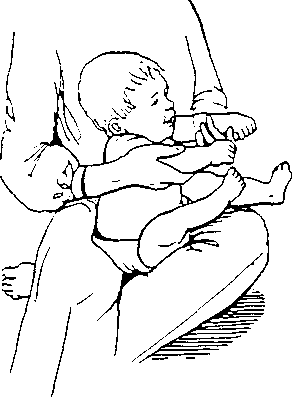
99 HOME INSTRUCTIONS
Lateral Tilt (Sitting on Legs)
Purpose
To develop head and trunk balance reactions in sitting position
Instructions
1. Place child in sitting position over your legs. You may hold child at the hips or on the legs to make child feel more secure (see Figure 1).
2. Slowly tilt child to one side by slightly lifting your leg (see Figure 2).
3. Repeat with other leg.
Desired Response
Child will attempt to keep head and body in an upright position.
Undesired Response
Child will fall into the direction of the tilt. Legs or back will become stiff.


100 HOME INSTRUCTIONS
Partial Pull to Sit
Purpose
To aid infant in attaining head control
Instructions
1. Sit with your back against a support. Bend your knees to make a wedge.
2. Place infant sitting in your lap with head on your legs and infant's legs on your chest .
3. Hold infant under the shoulders, rounding them forward slightly (see Figure 2).
4. Slowly lift child to sitting position (see Figures 3 and 4).
5. As child's ability to lift the head increases, gradually straighten your legs until infant can lift head from flat surface.
Desired Response
Infant will lift head.
Undesired Response
Head will fall or pull backwards. Arms will bend strongly or infant will push back with shoulders
Special Instructions
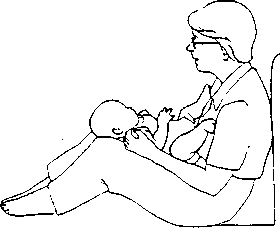
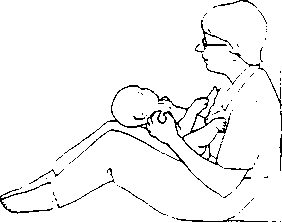
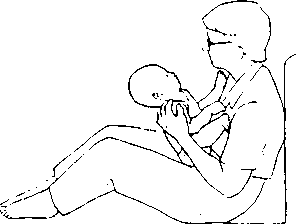
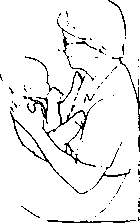
101 HOME INSTRUCTIONS
Pull to Sit
Purpose
To aid child in attaining head control . '
Instructions
1. Place child lying on /back with your hands under shoulders and elbows. Shoulders should be rounded forward slightly. Keep elbows straight (see Figure 1).
2. Slowly lift child to sitting position (see Figures 2 and 3).
Desired Response Child will lift head.
Undesired Response
1. Head will fall backward.
2. Arms will bend strongly or child will push back with shoulders. Special Instructions
